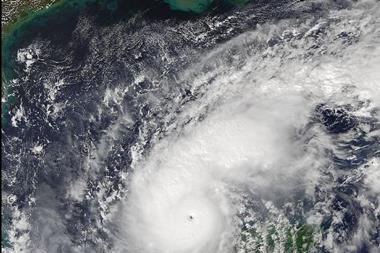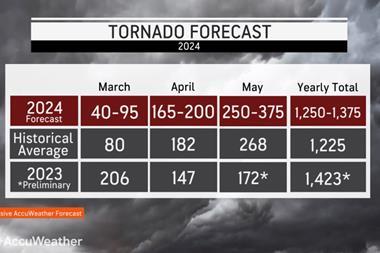Almost nine out of ten businesses are impacted by the weather. In other words, the fortunes of 88% of companies depend on meteorological conditions.
Just a few weeks ago, we heard that shopping malls, DIY stores and garden centres in the UK had suffered an 11% drop in footfall over the Easter weekend as shoppers elected to stay outside to enjoy an unseasonably warm April holiday.
Traditionally, retailers would chalk up a weekend of poor sales to bad luck and hope for rain next year. However, the insurance industry, which has been fighting to remain relevant in recent years faced with competition from other types of capital provider, thinks it may have a solution.
Ironically, that solution was born out of one of the worst failures in corporate risk management in history: the Enron scandal.
Before it bankrupted itself in an enormous accounting fraud scheme, the one-time US energy company became the darling of Wall Street by creating derivatives for sectors ranging from news media to insurance risk.
Shortly before the turn of the millennium, Enron sold the first weather futures instrument, agreeing to pay an energy company $10,000 for each degree it fell below the average temperature that winter.
And now insurers are trying to convince clients to use that sort of trigger in their own insurance programmes. Those triggers can be anything from levels of rainfall to wind speed, as long as it can be shown that the event would cause a loss.
“We can take the ground shaking or the magnitude of an earthquake as the trigger or also the category of a hurricane,” said Martin Hotz, head of parametric nat cat, at Swiss Re Corporate Solutions.
That means that underwriters depend almost solely on historical records to price a policy.
“The beauty of parametric insurance is that as long as there’s good quality data, you can write potentially policies anywhere, obviously subject to typical exclusions such as geopolitical risk,” says Paul Ramiz a director for Aon’s Innovation and Solutions team.
He says parametric policies most commonly rely on weather-related triggers, such as high or low temperatures, rainfall levels or wind speed.
“The reason it works very well in weather is because there is good meteorological data globally, in some instances going back for over 100 years.”
At the moment energy companies are some of the biggest buyers of parametric cover, as they seek to offset the risk of fluctuating temperatures affecting supply and demand. But it’s also used in the agriculture sector where crop yield can serve as a trigger.
Ramiz says parametric insurance has also caught the attention of finance bosses in the construction industry, who buy the cover to offset the cost of lost days following heavy rain, as well as government bodies looking for a policy offering a cash injection efficiently and quickly following a major catastrophe.
First principles first
One of the first principles of insurance states that the insured should not be left better off after a payout than they were before the incident that triggered a claim.
To avoid a conflict with first principles, parametric insurers establish an insurable interest before a contract is signed.
Ramiz explains that parametric insurance is an agreed-value policy, much like travel insurance, which specifies in advance how much policyholders will be paid in certain circumstances, such as suffering a flight delay.
Christian Wertli, who is head of innovative risk solutions at Swiss Re Corporate Solutions, says: “The clients are free to decide what to use the pay-out for exactly as long as they use the money for some of their incurred loss and incurred loss could be loss of revenue, increased expenses, denial of access, non-physical damage business interruption - I mean you literally name it.”
Ramiz says the cover was looking to fill the gaps in a traditional property policy. “If there’s no material damage, or physical damage, or business interruption coverage because there’s not been a physical loss then a parametric policy can fill the gap,” the broker explains.
He says that a traditional policy wouldn’t cover a construction company if its workers had to delay a project because heavy rain had partly flooded a site. Nor would it cover seed producers whose production suffered from a washout storm.
“The physical loss isn’t covered, it’s covered by a parametric cover because we establish that there is an insurable interest as these businesses are dramatically impacted from a profit and loss perspective if the weather goes against them.”
“We look at what the cost is of the contract, we look at what the day rate is - for example - in construction, or we look at what the expected cost of a megawatt hour is expected to be in an energy tariff. That establishes your sums insured and quantifies what and where the insurable interest is.”
He says that parametric cover is best suited to sophisticated buyers with risk managers, such as energy companies or other firms with big balance sheets.
Ramiz explains that claims payment is quick and efficient and the policy wordings are short because the buyer and insurer just need to define a location, risk period, sum insured and the event.
But there are downsides says Ramiz, who explains that a weather event could causes damage but not result in a payout because the conditions were not extreme enough to trigger the policy.
He also highlights the price of policies as a potential downside. He says that the greater the probability of a weather event occurring, the higher the price of the policy, much like a traditional policy in which buyers pay a premium to lower their deductible.
But he says: “Parametric policies are based upon data there is a risk the data may not align with the risk location, however the rise in gridded datasets and improving data capture is removing this hurdle.”
Wertli says that in a normal situation, the client would notify their broker or carrier of a loss or an insurer pro-actively checks if a policy has been triggered and makes a payment within 30 days.
However, he notes that in the unlikely event that the payment exceeds the actual loss the policyholder would have to refund the difference to the insurer. But the executive noted that was very unlikely because the definition of loss is intentionally “very very broad”.
His colleague, Hotz, explains: “The intent of the policy is that essentially the proof of loss concept is extremely broad.”
He says that is because they do not want to get bogged down in adjusting claims, as well as looking at policy exclusions and sub limits, which can mean policyholders are not paid for 18 months - in some cases leading to litigation.
“It’s not to say that the traditional policies are doing a bad job, they cover what they’re supposed to cover.”
“But, most of our clients who have bought these instruments have been through nat cat situations over the past few years and they realised first-hand that in today’s economy - where assets for corporations very often are intangible and intangible assets traditionally are very difficult to insure - they were retaining a bigger share of the loss than they were first anticipating,” he says.
“They suffered and took away a lesson. With these clients it’s a very different discussion to have than with clients who have been luckier in the past.”




















No comments yet